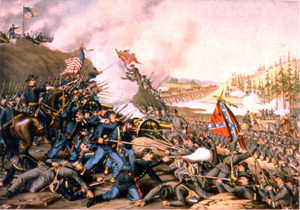
Battle of Franklin
Following the evacuation of Atlanta, Confederate General John Bell Hood formulated an elaborate plan to draw General William T. Sherman away from that city and place his own army in position to recapture Middle Tennessee. Hood planned to march his army north, capture the vital Union supply depot of Nashville, and take the war into Kentucky and Ohio.
Initially Hood’s plan worked. Sherman withdrew from Atlanta and followed the Army of Tennessee into North Georgia. There, Sherman realized the numerical superiority of his forces and detached a portion of his army to stay ahead of Hood’s advance north, while he returned with the main force to implement his March to the Sea. General John Schofield, Hood’s West Point classmate, was placed in command of the Fourth and Twenty-third Army Corps and given the task of slowing the Confederate advance to Nashville.
On the afternoon of November 29, 1864, the Army of Tennessee managed to get between Schofield’s command and the federal stronghold at Nashville at the town of Spring Hill. When the Confederate forces failed to cut the road north, the Union troops marched by their enemy in the middle of the night. By the next morning, they had entered Franklin and occupied a series of earthen fortifications on the southern edge of town. During the day, Union soldiers strengthened their already formidable position as Schofield made plans to evacuate Franklin and march to Nashville.
When Hood awoke on November 30 and found that the Union army had escaped, he blamed everyone but himself for the missed opportunity and immediately marched the Army of Tennessee to Franklin. Arriving at Winstead Hill (two miles south of Franklin), Hood determined to make a fight despite the warnings from Generals Nathan Bedford Forrest and Benjamin Cheatham to avoid a frontal assault. The Confederate commander accepted no counsel and ordered his subordinates to prepare for the assault.
At 4:30 in the afternoon, as the sun began to set, the Army of Tennessee stepped off in a three-mile-long battle line to launch the last grand charge of the war in Tennessee. Marching forward in near-parade formation, the leading elements of the Confederate line overwhelmed the advanced Union position one-half mile in front of the main line. Chasing the fleeing Federals, the men of Generals Patrick Cleburne’s and John C. Brown’s divisions smashed into the Union earthworks along the Columbia Pike. Driving the Federals through the front and back yard of Fountain B. Carter’s house and into the front yard of Albert Lotz’s home, the advancing Confederates met a counter charge by Colonel Emerson Opdycke’s brigade. In fierce hand-to-hand fighting, the Federal soldiers forced the Confederates back to the outer ditch of the main earthworks.
The Confederates made as many as eighteen separate charges but failed to make a significant breach in the Union defenses. Some Confederate attacks occurred so late at night that the soldiers used torches to guide their lines forward. The fight lasted until ten o’clock, leaving Union troops inside the works and Confederates in the outer ditches only a few feet apart. Many soldiers sat with their backs against the works and held their muskets over their heads to fire them into the opposing ranks.
After five hours of bloodletting, the small arms fire died away. Schofield wasted no time pulling his men out of their positions and marching them toward Nashville. That night, as the temperature dropped, the wounded Union and Confederate soldiers left on the field suffered terribly. The dead and dying lay in heaps sometimes five or six deep in the outer ditch. Field hospitals in the Carter and Lotz houses and the Carnton Mansion, treated the seemingly endless stream of wounded.
The battle exacted a disastrous toll on the Confederate forces. Hood sent approximately 23,000 soldiers against a fortified line protected by 15,000 Union soldiers and incurred 7,000 casualties, while the Federals lost approximately 2,500. Of the one hundred Confederate regimental commanders, sixty-three were killed or wounded. The casualty toll among Confederate generals was also high–six killed, five wounded, and one captured. As the Army of Tennessee moved north toward Nashville, a colonel commanded General John C. Brown’s division, and a captain led General Hiram Granbury’s brigade. At the battle of Nashville, two weeks later, the Army of Tennessee was not effective, having left a sizable number of hardened veterans and officers on the field of Franklin.
Suggested Reading
Wiley Ford, Embrace An Angry Wind (1992)



